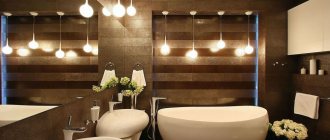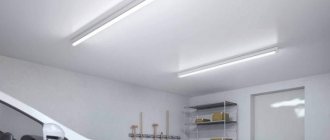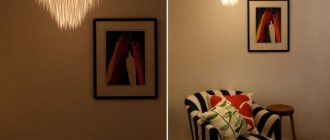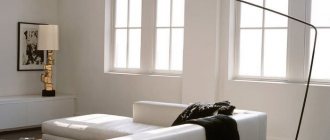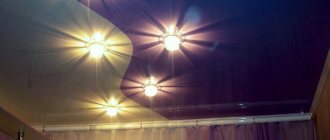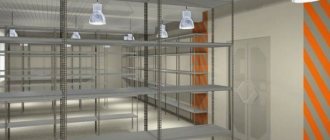When designing a room for a child, you need to take into account many aspects regarding the design - this applies to the choice of furniture, interior items, selection of wallpaper and other things. Also an important detail is the selection of the correct lighting for this room, since the selection of the correct artificial and natural light is very important for children's eyes. When developing a design project in graphic terms, it is necessary to correctly distribute the light in the children's room.
Lighting in a children's room affects the child's overall well-being, his psychological mood and the formation of his vision.
Options for planning children's room lighting
When choosing a room for a child, you need to take into account not only artificial, but also natural lighting that comes from the windows. Ideally, if the children's room faces southeast or east, then the light will fall in the right amount in the morning with the first rays of the sun, during the day it will softly illuminate everything around, and in the evening it will be replaced by electric lamps.
There should be no overly bright places or dark corners in the children's room.
If the windows face north or west, then when planning the design you need to take into account that there will be little light entering the children's room and this can be compensated for by properly distributing artificial lighting in the children's room.
When choosing lamps, you should give preference to durable structures rather than choosing chandeliers made of fragile glass. If this is a boy's room, then he may decide to play ball, and such a chandelier may suffer from this and be broken.
The correct placement of sockets in the interior is very important, since if a small child has access to this dangerous source of current, then this can result in serious consequences. If the outlets are not hidden under different surfaces or are in places accessible to children, then you can choose options with increased safety. Currently, there are many such options: closed with a lid, locked with a key, etc. Long wires that lie under your feet will prevent the child from moving freely around the room - it is better to hide them in the wall, run them along the eaves, and cover them with special plastic cases.
The number and location of lamps depends on the size of the room
Ideally, you need to create evenly diffused soft lighting throughout the room.
What should you pay attention to?
The children's room is fundamentally different from other rooms in the apartment, because the baby can often be left alone there. Therefore, the first thing that needs to be ensured in the nursery is safety. If a small child lives in the room, you need to ensure that all lighting fixtures are inaccessible. A curious baby may become interested in the lamp and get burned or injured.
It is worth abandoning overly massive and fragile chandeliers.
Plastic specimens in a broken state are not capable of causing harm to a child, and among glass models it is worth choosing lamps with shades made of tempered glass.
But even the choice of plastic lampshades should be treated with caution. Some cheap plastic models begin to emit harmful chemical compounds into the air when heated.
.
Instead of floor lamps, you should choose wall sconces for the children's room. During active games, the likelihood of dropping a lamp standing on the floor is much higher than breaking a wall-mounted fixture.
It is advisable to arrange sockets and switches so that they are inaccessible to a young child.
For a baby's room, it is better to give preference to sockets with protective plugs or special curtains that open only when the plug is inserted. It is better if they are hidden behind furniture. At the same time, too long wires also pose a danger during outdoor games.
For older children, such strict requirements are not necessary; on the contrary, they must learn to handle electrical appliances correctly and carefully.
Nuances of lighting design
In order to correctly place light supply devices in this room, you need to take into account:
- child's age;
- the presence of various functional areas in the room - for playing, studying, sleeping;
- presence of natural light.
When zoning the space, you need to take into account that the play area needs bright ceiling lighting, which will not be harmful to the eyes and will allow the child to see the smallest details in puzzles, construction sets and other games. It is not necessary for this room to have dark corners, but too bright light will be harmful, it will cause the child excessive irritability, and will have a detrimental effect on the nervous system.
You can use a chandelier or slot lamps as central lighting.
It is advisable to place the workplace near a window so that the desk is well illuminated by daylight
Another important area is a place for studying, drawing, and reading. There is no need for overhead lighting for it - a table lamp that can freely stand on the table or be attached to it with clothespins or other fasteners would be ideal for use. When choosing such a lamp, you need to consider its benefits:
- It will preserve the child’s posture and vision.
- Will make various types of classes and educational processes convenient.
- It will create comfort, thanks to which such activities will be enjoyable.
The third zone in this room is a place for rest and sleep. It doesn’t require a lot of light bulbs, but only soft light coming from a night light will do.
Decorative night lights in the form of luminous toys are appropriate in a small child’s room.
For older children, table lamps located next to the head of the bed are suitable.
No. 8. Consider additional night lighting
Almost all children are afraid of the dark and monsters under the bed. Install a small night light so that the child is not so scared.
The night light should not illuminate the room - it is just a small island of soft light in the darkness. In addition, it does not need to be installed next to the bed - the light can distract and prevent you from falling asleep.
Install a small wall light near the nursery door - turn it on at night if necessary
General light
Division into zones can be done by integrating lighting into a suspended or plasterboard ceiling, into an arch, or by distributing hanging lamps around the entire perimeter. The light in the nursery should be neutral white for the main lamps and yellow for the bedside sconces.
The lamps must be evenly distributed across the ceiling so that the entire area of the room is illuminated equally well.
It is ideal to use LED bulbs due to the following advantages:
- Positively affects the baby's vision.
- The eyes become less tired.
- The light bulb consumes little energy.
- It has a low heating level and is durable in use.
- It is difficult to break as it is made of matte plastic.
When choosing lamps hanging from the ceiling, it is best to choose models in which the light is directed not downwards, but to the sides or up. This type will better diffuse electric lighting throughout the room.
Lamp with economical LED lamps in a nautical-style nursery
Features of choosing lamps and fixtures
There are no additional criteria other than those already listed when choosing lamps and fixtures. Just a few additional points that may help.
- It is better to use LED light bulbs - this is the most environmentally friendly source of lighting and has a wide selection of colors that are suitable for decorating any children's area. However, you should not choose white. Warm yellow is better, which does not irritate the eye and is close to natural.
- Fluorescent lamps should be used with caution, as they contain mercury vapor (absolutely safe in the whole lamp), but in a child's room, especially if the child has not yet grown up and loves active games, the chance of damaging it is higher.
- Conventional incandescent lamps have a color spectrum that is closest to natural, so from the point of view of eye health, such lighting is optimal. Their big disadvantage is that they do not help save energy.
- An alternative to all of the above can be a halogen lamp. It is economical (not like LED or fluorescent, but more than incandescent), does not contain mercury and emits the spectrum of the visible part of sunlight, i.e. does not tire or irritate the eyes.
- When choosing, carefully study the information from the manufacturer. You should be careful when handling plastic products, because if it is of poor quality, it can melt from heating.
Suitable types of lighting fixtures
A rounded ceiling lamp is well suited for main lighting, a floor lamp or sconce for bedside lighting. With the help of ceiling spots, you can divide the room into zones: play, relaxation and study.
Open lighting fixtures are not suitable for organizing lighting in a children's room. Such lamps “hit” the eyes and can cause vision impairment. In addition, while playing, a child may accidentally break a light bulb that is not protected by a lampshade.
When choosing, it is important to consider the practicality of the lamp, that is, the ease of its removal and maintenance (cleaning from dust).
Optimal lamp types
Household lighting can be organized using incandescent, halogen, LED and fluorescent lamps.
Incandescent lamps provide a spectrum of light that is optimal for the eyes, but they are not energy efficient.
Fluorescent lamps will save on lighting costs, but they contain mercury vapor and can be dangerous if damaged. And in a nursery, where a child can play outdoor games, the opportunity to break it is quite large.
Halogen lamps do not contain hazardous components, have an optimal spectrum of light for the eyes and are 2-3 times more economical than incandescent lamps. They can be used to create basic lighting, in bedside and tabletop floor lamps.
LED bulbs, which are safe and economical, are well suited for additional lighting and for beauty and design.
The power of the lamp must match the lamp. There are lamps with parts that are not designed for high heating of the bulb. In this case, you should use a lamp of lower power or a different type.
Attention! When choosing the type of lamps, give preference to those that shine with a soft yellowish light. It is better not to use white light, which, when used for a long time, contributes to eye fatigue and, in addition, affects the child’s well-being.
After choosing the actual light bulbs, the stage of choosing a lamp follows. There are different types of them. A rounded flat one is suitable for the ceiling, which will provide enough light and be protected from damage. Or, if the room is small, you can use spots as ceiling lighting for a nursery, or any other room, arranging them in a rectangle, semicircle or in any other order in accordance with the shape of the room and individual wishes.
Natural light
The penetration of sunlight is a natural source of lighting, it is useful not only for children, but also for adults. In order for a large amount of natural light to enter this room, you need to select curtains made of loose fabric and light, soft shades. With intense sun penetration in south-facing windows, it is necessary to use thicker curtains, since an excess of such light is also not necessary.
Natural light is the most optimal for a child's eyes
If necessary, you can completely abandon decorating the window with curtains.
No. 3. Organize background lighting
General lighting creates a light background in the room, so it should be uniform and not too bright. It is better to abandon ordinary bulky chandeliers in favor of more modern and practical devices: flat ceiling lamps, spots or LED lighting.
If the nursery has suspended ceilings, it makes sense to install spotlights in them - they are very convenient and practical
Lighting in a boy's room
To emphasize the natural light in a boy’s nursery, you can choose sky-blue shades of curtains, which will also fit well with the design of the entire room, and yellow and green curtains can be suitable for children of both sexes. You can hang strict chandeliers made of durable materials and using LED bulbs on the ceiling. If the room is decorated in the style of some kind of fairy tale, a movie about heroes, then lamps, sconces, and night lights need to be selected so that they emphasize the overall design solution.
Slots that can be moved along a guide rail are used as general lighting
Modern solution - built-in linear LED lamps
Zoning and lighting
Lighting in a child’s bedroom consists of two types: general and local. The latter provides illumination for the work and play areas. The following lighting solutions are common:
- In a baby's room, you can limit yourself to overhead lights and a night light.
- Younger preschoolers may need lighting in the play area if there is not enough general lighting. A night light will be useful if the child does not like to fall asleep in the dark.
Zoned backlight Source pinimg.com
In the girl's room
For a little princess, pink, lilac, yellow curtains that will beautifully scatter light around the room will look impressive on the windows to softly transmit the sun's rays. There is a wide variety of different lamps on sale in the form of flowers and even dolls, which will not only perform a practical function, but also look aesthetically beautiful and stylish.
For a little girl’s room, you can choose interesting lamps in the shape of animals or toys.
A teenage girl will be interested in modern models of lamps, matched to the style of the room.
Types of lamps
Lighting in a nursery is of great importance, since its quality is very important, not harming children's vision. When choosing lamps, you need to be guided not only by your taste and their appearance, but also pay special attention to the material from which they are made, their performance qualities and their style, which corresponds to the overall design of the entire nursery space. There should be no fragile things in this room, especially for small children living in it, who can play a little and break something, and this also applies to lamps located on the ceiling, wall or shelf. Therefore, they must be made of durable material and well fixed to a vertical or horizontal surface.
A lamp in the shape of a moth would be appropriate in a small child’s room
You can make such a lamp yourself from wood and colored ropes.
Hooked
To emphasize the style, which involves paying attention to interior details, this also applies to lighting, chandeliers, lamps and sconces that are mounted on the wall with hooks. This type of mount is very convenient for securing lighting fixtures and would be ideal for a nursery.
Wall night light in the shape of a pink flower
Spot
These types of lamps are widely used for suspended, suspended or plasterboard ceilings in children's rooms.
Implementation of general lighting using spotlights built into the lower tier of a two-level ceiling
Advantages of using point devices:
- If you have low ceilings, it will be inconvenient to use hanging chandeliers, and the use of this type of lamps, using their ability to reflect light, will also make these ceilings visually higher.
- With the correct distribution of light over the entire surface of the ceiling, they not only visually expand the space, but also have a beneficial effect on the child’s vision.
- They meet safety requirements for children.
- With their help, you can carry out the necessary zoning of the children's room.
- Some models have adjustable light brightness.
- With their help, you can create fantastic patterns, drawings, emphasize contours, and mark the boundaries of a multi-level part of a plasterboard ceiling.
Using spotlights mounted in a shelf above the workplace, you can provide uniform illumination of the desk
Ceiling
The main sources of light have always been lamps hanging from the ceiling. You can use this method to illuminate a table for homework, drawing, and other activities that require bright lighting. The play area also needs this kind of lighting.
The appearance of the ceiling lamps should be combined with the overall design of the room
No. 7. Add mood lighting
The children's room should be bright and cheerful. And you can make it look like this using LED and strip lighting - highlight individual elements of the interior with light: the edges of the ceiling or niches in the walls.
Your child will be more willing to go to bed if you decorate the ceiling above the bed with an LED “starry sky”
Photos of examples of children's room lighting
In this room you can see the implementation of a children's design project in the spirit of a fairy-tale forest, which is favorably emphasized by lighting that has different colors and softly diffuses the light. On top of the sofa, spotlights are built into the plasterboard ceiling, additionally illuminating this area, but above the bed, on the contrary, there are none to create a comfortable stay in this area for sleeping and relaxing.
To place spotlights in the children's room, arrange a two-level ceiling
This nursery belongs to two children of different sexes, which is divided into two zones using a partition that turns into an arch. Each part has a window with curtains of different colors, which highlight the soft, natural light that penetrates into this room. Artificial ones include built-in spotlights in the ceiling covering; pay attention to the photo of the sconce in the nursery above the bed.
Each zone is decorated in its own color scheme
In this room you can see the successful use of several types of lighting: natural for the study area, spot and basic in the form of several lamps located in the central part of the ceiling.
The main lighting is provided by spotlights, wall sconces are placed above the bed, and a table lamp is used to illuminate the desktop in the evening.
No. 1. What factors should be considered?
There is no universal formula by which one could calculate how many light bulbs need to be used and in what place to place them. In each children's room, the issue is resolved individually, and depends on numerous factors: the size of the room, the number and parameters of windows, the direction of the world on which the windows face, the age of the child, the materials used in the decoration , etc.
It is advisable to create a lighting plan at the renovation planning stage: it is important to think about not only what furniture will be used, what the walls and floor will be like, but also where the main and additional light sources will be located. You need to be very careful when choosing the brightness of the lamps: you need to prevent twilight in the room, but the light should not be too bright, so as not to give unnecessary glare on individual objects in the room. The entire space should be evenly illuminated: a sharp transition from light to shadow is unacceptable.
As for the external appearance of lamps, today the choice is so wide that a child’s room can be decorated in any style, and chandeliers and sconces will resemble fairy-tale characters, have the shape of an airplane, a kite, etc.



